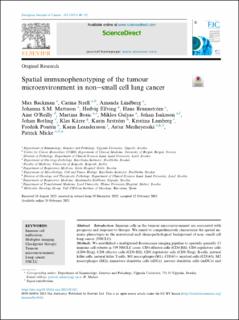Spatial immunophenotyping of the tumour microenvironment in non–small cell lung cancer
| dc.contributor.author | Backman, Max | |
| dc.contributor.author | Strell, Carina | |
| dc.contributor.author | Lindberg, Amanda | |
| dc.contributor.author | Mattsson, Johanna S.M. | |
| dc.contributor.author | Elfving, Hedvig | |
| dc.contributor.author | Brunnström, Hans | |
| dc.contributor.author | O'Reilly, Aine | |
| dc.contributor.author | Bosic, Martina | |
| dc.contributor.author | Gulyas, Miklos | |
| dc.contributor.author | Isaksson, Johan | |
| dc.contributor.author | Botling, Johan | |
| dc.contributor.author | Kärre, Klas | |
| dc.contributor.author | Jirström, Karin | |
| dc.contributor.author | Lamberg, Kristina | |
| dc.contributor.author | Pontén, Fredrik | |
| dc.contributor.author | Leandersson, Karin | |
| dc.contributor.author | Mezheyeuski, Artur | |
| dc.contributor.author | Micke, Patrick | |
| dc.date.accessioned | 2024-02-14T14:24:25Z | |
| dc.date.available | 2024-02-14T14:24:25Z | |
| dc.date.created | 2023-06-26T08:29:04Z | |
| dc.date.issued | 2023 | |
| dc.identifier.issn | 0959-8049 | |
| dc.identifier.uri | https://hdl.handle.net/11250/3117630 | |
| dc.description.abstract | Introduction: Immune cells in the tumour microenvironment are associated with prognosis and response to therapy. We aimed to comprehensively characterise the spatial immune phenotypes in the mutational and clinicopathological background of non–small cell lung cancer (NSCLC). Methods: We established a multiplexed fluorescence imaging pipeline to spatially quantify 13 immune cell subsets in 359 NSCLC cases: CD4 effector cells (CD4-Eff), CD4 regulatory cells (CD4-Treg), CD8 effector cells (CD8-Eff), CD8 regulatory cells (CD8-Treg), B-cells, natural killer cells, natural killer T-cells, M1 macrophages (M1), CD163+ myeloid cells (CD163), M2 macrophages (M2), immature dendritic cells (iDCs), mature dendritic cells (mDCs) and plasmacytoid dendritic cells (pDCs). Results: CD4-Eff cells, CD8-Eff cells and M1 macrophages were the most abundant immune cells invading the tumour cell compartment and indicated a patient group with a favourable prognosis in the cluster analysis. Likewise, single densities of lymphocytic subsets (CD4-Eff, CD4-Treg, CD8-Treg, B-cells and pDCs) were independently associated with longer survival. However, when these immune cells were located close to CD8-Treg cells, the favourable impact was attenuated. In the multivariable Cox regression model, including cell densities and distances, the densities of M1 and CD163 cells and distances between cells (CD8-Treg–B-cells, CD8-Eff–cancer cells and B-cells–CD4-Treg) demonstrated positive prognostic impact, whereas short M2–M1 distances were prognostically unfavourable. Conclusion: We present a unique spatial profile of the in situ immune cell landscape in NSCLC as a publicly available data set. Cell densities and cell distances contribute independently to prognostic information on clinical outcomes, suggesting that spatial information is crucial for diagnostic use. | en_US |
| dc.language.iso | eng | en_US |
| dc.publisher | Elsevier | en_US |
| dc.rights | Navngivelse 4.0 Internasjonal | * |
| dc.rights.uri | http://creativecommons.org/licenses/by/4.0/deed.no | * |
| dc.title | Spatial immunophenotyping of the tumour microenvironment in non–small cell lung cancer | en_US |
| dc.type | Journal article | en_US |
| dc.type | Peer reviewed | en_US |
| dc.description.version | publishedVersion | en_US |
| dc.rights.holder | Copyright 2023 the authors | en_US |
| cristin.ispublished | true | |
| cristin.fulltext | original | |
| cristin.qualitycode | 2 | |
| dc.identifier.doi | 10.1016/j.ejca.2023.02.012 | |
| dc.identifier.cristin | 2157688 | |
| dc.source.journal | European Journal of Cancer | en_US |
| dc.source.pagenumber | 40-52 | en_US |
| dc.identifier.citation | European Journal of Cancer. 2023, 185, 40-52. | en_US |
| dc.source.volume | 185 | en_US |
Tilhørende fil(er)
Denne innførselen finnes i følgende samling(er)
-
Department of Clinical Medicine [2047]
-
Registrations from Cristin [9558]

